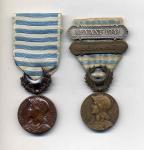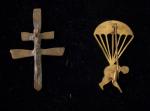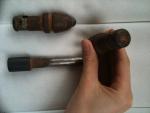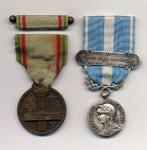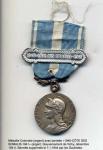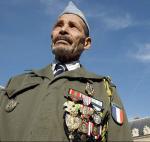-
Posts
2,284 -
Joined
-
Last visited
-
Days Won
6
Content Type
Profiles
Forums
Blogs
Gallery
Events
Store
Everything posted by PKeating
-
This is a reasonably good instant reference as much of the information seems to come from reputable sources: http://en.wikipedia.org/wiki/Syria-Lebanon_Campaign When I was eight, just moved to Chelsea in London, a Doctor Hyman, living next door, tended me when I got a dose of Tonsilitis, which soon cleared up. I suppose he was the man responsible for germinating an interest in military history as he showed me his mementos of this campaign as a medical officer, including his maps, bits of machine gun link, cartridges, photos, his webbing haversack, his medals and, the clincher, sand from the Syrian desert. Operation Exporter is indeed one of the largely forgotten or ignored campaigns of WW2, mainly because the censors worked hard to downplay it, but read this and you will understand what that little clasp "LEVANT - 1941" represents. I am not sure how British and Commonwealth personnel were rewarded. Most of them came from North Africa and went back there afterwards so they later had the Africa Star but I don't know if it actually covered the actions in Syria and the Lebanon. The campaign lasted just five weeks but the fighting was fierce, the French putting up an impressive fight, and two Victoria Crosses were awarded to Australians, including the famous Arthur Roden Cutler. The Gaullist administration outlawed the wearing of the LEVANT - 1941 clasp in 1944, which seems rather spiteful, given the circumstances, especially as they stipulated that the qualifying period for their Médaille Commémorative du Levant began on the day of the ceasefire, July 12th 1941, pending the surrender of French forces resisting the British invasion. The Vichy government was, after all, the legitimate authority in France at the time, and the Gaullists were just one of a number of factions claiming to represent the French nation. The French and colonial forces who put up such a good fight against the invasion of French territory by the British, and a few Gaullists, were fighting for the legitimate French government of the day. To the victors, the spoils, plus they get to write the history afterwards... PK
-

EK 1939 Eichenlaub zum Ritterkreuz des Eisernen Kreuzes
PKeating replied to Taurus454's topic in Germany: All Eras: The Iron Cross
Impossible to tell from the pics but have you tried mounting these on a cross? PK -
Hallo Chris. Not quite. Let me explain. The clasp "LEVANT - 1941" is the Vichy part of the medal. In this case, this particular medal, with the bronze clasp 'LEVANT', was awarded to someone who had fought against the Turks between 11.11.1918 and 20.10.1921, following Turkish massacres of Kurds and other atrocities. The medal was reactivated and awarded with another clasp, "LEVANT 1925-1926" for operations against the Druze rebels. And then the Vichy government used the same medal for the 1941 operations, with the "LEVANT - 1941" clasp, but calling it the Levant Medal rather than the Syrie-Cicilie Medal. In this case, the 1941 clasp is worn with the 1918-1921 clasp. Recipients not entitled to the 1918-1921 or 1925-1926 issues would have received a 1922-pattern medal from stock - I don't know if the 1922-pattern was restruck by Vichy but it could have been - with the 1941 clasp. The Free French reacted by created their own "Levant Medal", closely based on the 1922 design but omitted the words "Syrie-Cycilie" from the flag on the reverse of the medal as originally designed. The Free French medal is the chocolate brown one in the above photos. You can see the mark J.R.G. for J R Gaunt of London, who struck various medals for the Gaullist administration. The Free French medal was not awarded with a clasp. The Vichy clasp is hard to find and so is the London-made Médaille Commémorative du Levant. PK
-
The Levant Medal was based on the Commemorative Medal for Syrie-Cicilie (Médaille Commémorative de Syrie-Cicilie), instituted on 18.7.1922. Following the decree of 24.12.1941, the Vichy administration instituted the LEVANT - 1941 clasp for the by-then defunct Syrie-Cicilie Medal to reward French personnel loyal to Vichy and engaged in defensive operations in the region against Anglo-French forces between 8.6.1941 and 12.7.1941. They reutilised the 1922 medal and called it The Levant Medal. The Free French government-in-exile in London responded by instituting a Levant Medal of their own, struck by J R Gaunt of London and finished in the same chocolate brown as the firm's officers' cap and lapel badges. The Free French version had no clasp and the words "Syrie-Cicilie" were omitted from the reverse of the medal. The medal was awarded to personnel of the Free French Forces engaged in policing operations in the Levantine states between 12.7.1941 and 14.8.1943 and also personnel loyal to Vichy who had served at least two years in the region during the war.
-

Michael Collins cap badge Adams sale April 2010
PKeating replied to molders's topic in Northern European & Baltic States
I have an original solarised stone print of a photographic portrait of Sir Roger Casement done during his visit to Dresden early in 1916, before the Easter Rising. It was for a German propaganda book. I showed it to Adams in 2006, the 90th anniversary year, to see how reliable they were as valuers and they suggested that it might fetch about €300. Oh, and it's signed, with provenance back to the photographer via the German collector, a prominent hotelier of the 1900s up to the 1930s, and his family. There was almost total disinterest, which indicates a certain fundamental ignorance of the sort I recall encountering at Sotheby's and Christie's when it came to militaria and related ephemera. Doesn't make them rogues. It merely suggests that they might not be as expert as they wish people to think, as this Michael Collins' cap badge affair further suggests. PK -
I have dealt with Robert Seniso a few times and find him very honest, charming and knowledgeable. http://www.seniso.com/accueil.aspx He has a stock not shown on his website - yet - and he is very approachable. PK
-
Thank you, gentlemen. The descending paratrooper reminds me of small, unofficial badges I have seen. I have one somewhere, depicting a French military motorcycle and sidecar crew in their outfit. This is much the same style. If they are period items, I would venture a guess that they would have been akin to our 'sweetheart' badges. Here is the reverse. There again, they could be fantasy pieces. There is no provenance that I am aware of. All I know about them is that they were proposed in trade to me by a fairly serious collector of airborne memorabilia and the brass paratrooper badge reminded me of other pins I have seen in the past. PK
-

Michael Collins cap badge Adams sale April 2010
PKeating replied to molders's topic in Northern European & Baltic States
In Ireland, any scrap of old green cloth is a piece of the flag raised above the GPO in 1916 and everyone had an ancestor in the IRA... -
I am told that these could relate to the Free French parachute battalion raised in the Middle East and engaged in North Africa during WW2. I have certainly seen similar badges or "pins" relating to other units and presume that this would be an unofficial insignia, rather like some of the German unit and tradition badges. Can anyone help? PK
-

Heer The Duenkirchen Shield
PKeating replied to Peter BL's topic in Wehrmacht Medals, Decorations & Awards
There are very few photographs of happy, smiling soldiers from the siege pockets like Dunkirk, Lorient and Royan because photographic materials were a restricted resource. There are a few images in the archives that were intended for propaganda purposes but it was hard to get material in and out after a certain time, particularly in the case of Dunkirk, because of Allied air and sea superiority. Maybe there is a photograph somewhere of the Dunkirk Shield worn on the side of field caps or side hats. Maybe there is a roll of film somewhere of an award ceremony. However, for the moment, we have only a few eyewitness accounts of a handful of German personnel observed by Free Czech soldiers and attached FFI and FFL interpreters and the indisputable nature of the period award documents and paybook entries to support the contention that these little badges are genuine. As far as I am concerned, they are genuine - as long as they conform to certain manufacturing characteristics, of course - and the low number observed over more than three decades underscores my belief. It is like the French-made KM War Badges, which, amusingly, are now being faked in France: many people do not believe them to be period pieces as there are no photos of them being worn. Given that they were probably one of many product ranges inspired by the promotion of the idea of a Franco-German alliance as a building block for the New Europe, they were probably made late in 1940 or, more likely, early in 1941, and would have fallen victim to the tightening of rules in March 1941 by the German authorities governing the retail sale of awards. This would explain why the majority of them were consigned to the basement of the naval HQ in Paris, to be found there in the 1970s. Very logical. There was talk of someone seeing a German PK photo in the ECPA-D archives of three KM sailors in La Baule on leave, one of whom is wearing the Bacqueville-made Destroyer Badge on his walking-out dress, but nobody has yet located it and ordered a copy. Photographic evidence, as Phil Steele points out, is an important part of deciding the authenticity of insignia or, at least, if the insignia in question existed at the time. There were some hamfisted attempts to create some photos of a man wearing an Army Balloonist Badge but by and large, there don't seem to have been any serious attempts at this sort of fraud in our circles, bar one photo of a man wearing a type of Waffen-SS cuff title that some people contend existed but which never could have existed because it was not instituted by the Führer or Reichsführer-SS and, in any case, the unit in question was in the main a disciplinary unit. But the photographic prints exist and they are good enough to have convinced some normally skeptical people of their period authenticity. There again, if original materials are used - and more of these were available when the images first came to light - the results can be convincing. The other possibility is that these photos are wartime and that the man in them or a group of men from his unit had these cuff titles made up - they clearly involve RZM-type bands - but no veteran of the unit recalls anyone playing around with unauthorised unit cuff titles. Wearing something like that would have been quite a serious offence, given that it was essentially an award in the gift of Hitler or Himmler. Not good to get caught doing something like that. Anyway, my point is that photos are an important component and can often tip the scales but they are not necessarily an end in themselves. PK PK -

EK 1939 Eichenlaub zum Ritterkreuz des Eisernen Kreuzes
PKeating replied to Taurus454's topic in Germany: All Eras: The Iron Cross
I cared but not as much as I used to... -

Heer The Duenkirchen Shield
PKeating replied to Peter BL's topic in Wehrmacht Medals, Decorations & Awards
This shield looks absolutely fine to me. There are a couple of examples here in Paris, one of which is with the supporting paperwork, including the entry in the man's paybook. They are said to have been worn on fieldcaps, rather like tradition badges. I agree with Phil Steele about the other badges and awards he mentioned but the Lorient Shield was produced. Period examples are known and documented. There was even a French nurse who emerged from the pocket after the surrender with a couple in her possession but it seems to have been treated more as an unofficial keepsake than an actual award, rather like those Gebirgsjäger and Luftwaffe medallions and plaques produced by local commanders or even at regimental and battalion level, otherwise we would surely know of entries in paybooks and perhaps even award documents. PK -
Here's another type of wartime BIR HACHEIM 1942 clasp with the British spelling on a London-struck medal with what appears to be a British silk riband. The four clasps are all by the Paris firm of Arthus Bertrand, which indicates that they post-date the Liberation of Paris in August 1944. However, the Decree of January 7 1944, issued in Algiers by the Free French administration, had ordered the spelling modified to 'BIR HAKEIM", for French language-related phonetic reasons yet Arthus Bertrand produced dies with the British spelling and the date of the battle, like the clasp I showed a few posts ago.
-

EK 1939 Eichenlaub zum Ritterkreuz des Eisernen Kreuzes
PKeating replied to Taurus454's topic in Germany: All Eras: The Iron Cross
From the photos, this looks rather like one of those English copies from the 1990s with the loop that cannot actually be put through the ring on the cross. Of course, as Joe says, the photos are rather unclear so judgement should be reserved until better images are visible. PK -
Certainly, Bernhard! The clasp is on a par with the KOUFRA clasp but is British-made, indicating that it really is an early example, perhaps dating from late 1942, the clasp having been instituted in October 1942. PK
-
You should have jumped on it! The clasps with the British spelling are rare but the French-made clasps, with the later spelling, are also quite scarce. Not many were struck, given the relatively low numbers of veterans qualified to wear them. Here's another France Libre ensemble, again on a J R Gaunt medal with what appears to be a post-Liberation AFL clasp by the Paris maker Arthus Bertrand, although some people believe this to be a London striking inspired by that firm's style. I think it confirms precisely to AB products. Nice, though, a London Médaille Coloniale with a Liberation period clasp. PK
-
Up there with the KOUFRA clasp and like the KOUFRA clasp I showed earlier, this BIR HACHEIM 1942 clasp is quite special. Does anyone know why?
-
There was also a version for veterans of the 1871/71 war.
-

Kriegsmarine Juncker type u-boat badge
PKeating replied to JEANNOT's topic in Wehrmacht Medals, Decorations & Awards
I would buy the Juncker badge. The Schwerin badges are considered to be the "Rolls Royces" of KM war badges but Juncker versions are just as beautiful and, in my opinion, much rarer. PK -
Thank you all very much. I have passed your responses to the boy's parents. I was wondering if they might be tips from armour-piercing rounds but they do look like those road-milling machine parts. PK
-
Gents, I got an email today from a friend here in France saying that his son's mate dug these up on Omaha Beach (Normandy) this weekend. He asked if they were dangerous. I told him to tell them all not to touch it, pending either an identification or the arrival of the unexploded ordnance squad. Did I give them the right advice? And does anyone know what these are? PK
-
You could have posted them one after the other in the same thread. Offhand, I'd say that this is some sort of theatrical prop bearing a faint resemblance to the breast star of the Légion d'Honneur. The doorknob washer would have been highly polished to catch the light on-stage and reflect it towards the audience. PK
-
From la France Libre to l'État Français: I've shown these elsewhere in this section but the images have disappeared and more information has since come my way. The pair was obtained from the same source in France last year but, as is so often the case, the chineur or picker who found them had not looked for any related documents and the trail is now long-broken, which is a shame as the document for the Médaille du Mérite de l'Afrique Noire is probably ten times rarer than the medal, which is one of the rarest of French medals as it is. The original recipient was said to have served in a camel unit, which indicates méharistes from Chad. Perhaps he was a French NCO. The Côte des Somalis clasp was originally instituted in 1934 following a native rebellion. The clasp was subsequently awarded to French and native personnel for the rebellion of 1936/37. On 19.9.1941, the Vichy government reinstituted the clasp for military, paramilitary and civil personnel involved in the defence of the colony against British forces in 1940 and 1941. To earn the clasp required six months of unblemished service since 25.6.1940, when French Somalialand had declared itself if not unquestioningly loyal to the new collaborationist French government than at least not absolutely behind the Gaullists in London either. On 26.12.1941, the Vichy government instituted a new clasp, 1940 - Côte des Somalis - 1941, which is also shown here, as a replacement for the Côte des Somalis clasp to differentiate between recipients who had served during the rebellions of the 1930s and those deemed loyal to the New Order by virtue of their anti-Gaullist stance. It is interesting to note that the Royal Navy allowed Vichy ships through to resupply the garrison in Djibouti, which intensely irritated General de Gaulle, convinced as he was that French Somalialand would rally to his cause if put under sufficient pressure. Vichy liked to portray the French garrison in the colony as pro-Vichy but as with other outposts of the French Empire, one gets the feeling that they were all playing a waiting game before declaring for one side or the other. In the end, the Royal Navy did impose a blockade in the autumn of 1942 and British and Free French forces occupied Djibouti three months later, in December 1942. The 1940 - Côte des Somalis - 1941 clasp was amongst the Vichy awards outlawed by the January 1944 CLN decree signed in Algiers. However, some men who earned the Côte des Somalis clasp in 1940 and 1941 probably continued to wear it as the CLN were unable to ban it easily because of its previous history. Sadly, we have no way of knowing if the recipient earned this bar in the 1930s or during WW2 but given that the clasp seems to be of local fabrication in plated brass, the originals from the Monnaie de Paris being crisply struck in silver, it could well be that this clasp was awarded sometime in 1942 for service in the colony after the Franco-German Armistice of June 1940. The award of the Médaille du Mérite de l'Afrique Noire would also support this conjecture. What is particularly nice about this example, struck by the Monnaie de Paris, is that the recipient fashioned himself a little ribbon bar, so he clearly wore his Black Africa Merit Medal on his uniform with pride during WW2. By the way, the medal was awarded to Europeans and Africans alike. There was a variation of the clasp, again in the 'oriental' style in which the dates 1941-1942 appear after the Côte des Somalis legend. Hass states that this type was destined for French naval and airforce personnel based in Madagascar who participated in the attempts to break through the British blockade. PK
-



